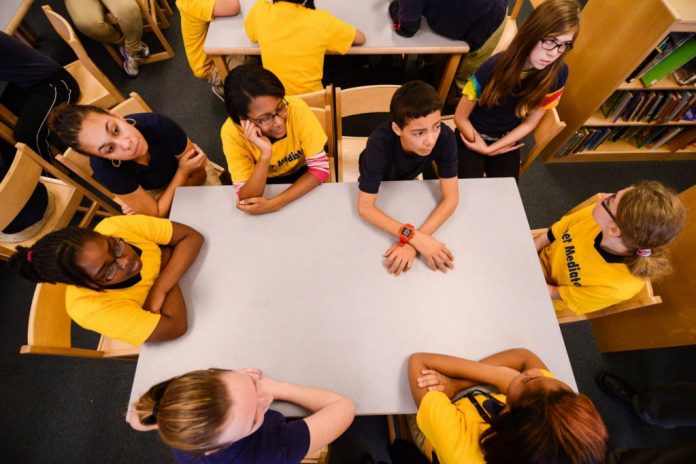Justin Jones is a big believer in the peer mediation program at Hamilton Disston Elementary School.
The eighth-grader, a mediator in the program, recalls one case of a group of students who were fighting among themselves. “They came to mediation and walked out shaking hands,” he said.
In mid-December, Jody Greenblatt visited Disston, at 6801 Cottage St. in Tacony, to learn about the program, which has been in existence for three years. Greenblatt was there because she works with the School Reform Commission on safety and discipline issues.
Principal Gregory Shannon assembled the 25 peer mediators in a classroom on Dec. 12 and told them they are a point of pride in the school. He put them on par with members of student government and the Disston Dragons, a group of students dedicated to creating a positive school climate.
“The younger students look up to you guys,” he said.
Peer mediators can join once they reach sixth grade. They take part in two days of intensive training. The training is ongoing once they are approved by the school.
The young people handle everyday issues such as bullying, fighting and rumors.
“It’s a lot of, ‘He said, she said’ drama,” said eighth-grader Kayla Applegate.
Students who engage in especially egregious acts are suspended or expelled. Some are eligible for reinstatement mediation.
Two mediators are assigned to each case. Assignments are made on a rotating basis.
Disputes are settled the same day, or the next day if they occur close to dismissal.
Both parties are brought to the student services room to try to resolve their differences.
“Sometimes, they come mad and sometimes they are pretty calm,” Justin said.
The agitators can decline to attend.
“If they don’t come to us, it goes to Mr. Boothman,” Justin said of George Boothman, the dean of students. “He’s an ex-cop.”
At the mediation sessions, participants receive strikes every time they interrupt, argue, fight or talk to each other instead of directly to the mediators.
“If they get three strikes, they go to Mr. Boothman,” said seventh-grader Mellisha Harrigan.
Most times, though, Boothman does not have to get involved.
The mediators use a pre-printed checklist of questions to try to get to the bottom of the dispute. The case ends when the mediators believe the combatants have settled their differences.
“They sign an agreement that they won’t carry it out of school,” said eighth-grader Shaylece Smith.
“It’s like a contract,” said seventh-grader Aaliyah Briggs.
Teachers Cindy Rosen and Grace Scafide oversee the program. They believe the mediators gain respect and learn conflict resolution and how to become leaders and show poise in tough situations.
“When they’re involved in mediation sessions, they’re developing lifelong skills,” Scafide said.
Rosen and Scafide attend the mediation sessions but do not interject comments.
“The meetings are totally run by students,” Rosen said. “It’s just amazing to watch.”
Scafide said the mediation program is successful because sessions are held daily, not weekly, thus nipping the problem before it gets out of hand. She also gives much of the credit to the mediators.
“They’re an asset to the school,” she said. ••
Reporter Tom Waring can be reached at 215–354–3034 or [email protected]





